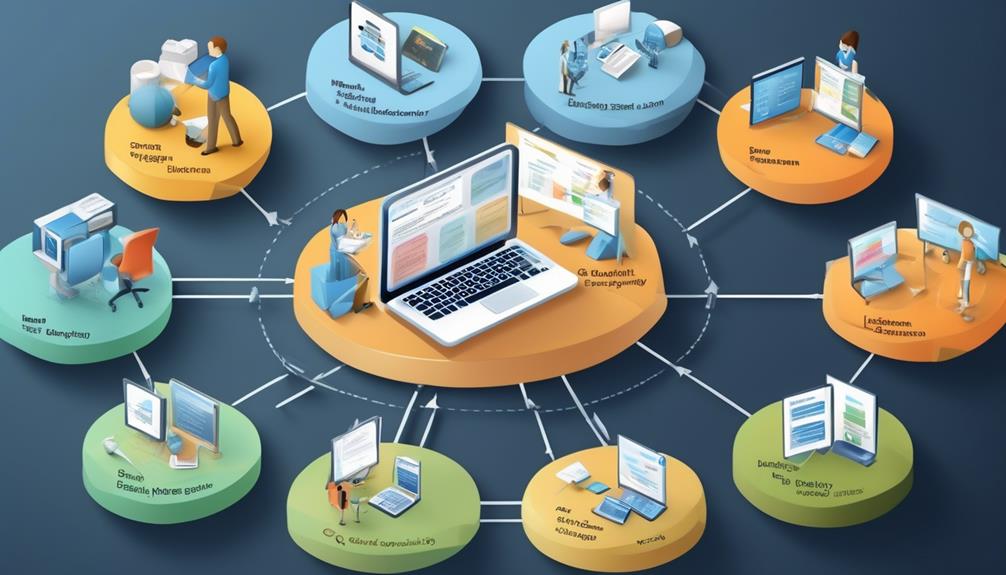SQA Techniques and Tools
Latest QA Technologies
Stay ahead with the latest QA technologies. Learn about automation, AI, and more to improve your testing processes and deliver high-quality software products.

In the constantly changing realm of software testing, it is widely recognized that change is the only thing that remains constant.
As we navigate through the latest QA technologies, we find ourselves at the intersection of innovation and necessity.
From AI-driven test automation to performance testing innovations, the landscape is continuously shifting, presenting us with new challenges and opportunities.
As we explore the advancements in this dynamic field, we uncover the key drivers behind the transformation and the potential impact on software quality and delivery.
Key Takeaways
- AI-driven testing technologies are revolutionizing the testing process by integrating AI and automation, minimizing manual testing, and enhancing accuracy and consistency of test results.
- Performance testing innovations are crucial for continuous delivery and performance engineering, ensuring seamless performance of AI and machine learning applications.
- Mobile testing advancements focus on compatibility, performance, and security testing for mobile apps, as well as integration with automation tools and DevOps toolchains.
- Test environment optimization maximizes efficiency by leveraging AI and machine learning, streamlining resource allocation, and minimizing infrastructure complexities.
AI-Driven Test Automation
How can AI-Driven Test Automation revolutionize the efficiency and reliability of software testing processes?
AI-Driven Test Automation, a pivotal advancement in quality assurance, integrates artificial intelligence and automation to streamline software testing. By harnessing AI and machine learning algorithms, this innovative approach minimizes the reliance on manual testing, thereby enhancing the accuracy and consistency of test results.
It enables agile and DevOps teams to execute continuous testing seamlessly, aligning with the rapid development cycles of modern software. The incorporation of AI also facilitates the development of intelligent testing tools that can adapt to evolving application landscapes, ultimately bolstering the overall quality of software products.
Furthermore, the utilization of AI in test automation extends to personalized support and query resolution through chatbots, contributing to efficient issue resolution. The trends in AI-Driven Test Automation signify a significant surge in its adoption, underlining its growing relevance in the realm of software testing.
As AI continues to evolve, its integration into test automation processes is poised to shape the future of quality assurance and software testing methodologies.
Performance Testing Innovations

The current landscape of performance testing is witnessing remarkable technological advancements that are revolutionizing the way software applications are tested for their performance and scalability. Innovations in performance testing encompass a wide array of testing types, such as load testing, stress testing, and scalability testing, all aimed at ensuring the optimal functioning of software applications under varying conditions.
These innovations are crucial in the realm of continuous delivery, where the emphasis is on integrating performance engineering into the development lifecycle. The advent of advanced testing solutions and performance testing tools like JMeter and LoadRunner has significantly enhanced the efficiency and accuracy of performance testing processes.
Moreover, these innovations play a pivotal role in conducting quality checks for AI and machine learning embedded in IoT-based applications. Next-generation performance testing service providers are instrumental in ensuring the seamless performance of business-critical mobile and web applications.
In essence, performance testing innovations are shaping the future of software development by enabling organizations to deliver high-performing and reliable applications to their users.
Mobile Testing Advancements
Mobile testing advancements have become indispensable in response to the surging demand for mobile applications and the increasing diversity of devices and operating systems. The following developments are shaping the landscape of mobile testing:
- Compatibility testing across multiple platforms is crucial to ensure a seamless user experience across different devices and operating systems.
- Performance and security testing for mobile apps are essential to guarantee the reliability and safety of applications in a dynamic environment.
- Integration between cloud-based mobile device labs and test automation tools can significantly enhance mobile automation, improving the efficiency of mobile testing processes.
- The trend of automated testing for mobile apps continues to rise, making it a significant area of advancement in mobile testing.
- Mobile test automation must be integrated into DevOps toolchains to ensure the delivery of high-quality mobile applications in agile testing environments.
These advancements are vital for meeting the challenges posed by the proliferation of IoT devices and the increasing reliance on mobile applications in the era of cloud computing.
As mobile testing continues to evolve, it plays a pivotal role in ensuring the seamless functioning and security of mobile applications.
Test Environment Optimization

Test Environment Optimization involves the strategic configuration and management of the testing environment to maximize efficiency and effectiveness, aiming to closely mirror real-world production environments. This process is crucial for ensuring software quality, assurance, and a seamless user experience. By leveraging the latest QA technologies such as AI and machine learning, organizations can optimize their testing process and automation capabilities, leading to enhanced development and testing outcomes.
| Key Aspects of Test Environment Optimization | Benefits |
|---|---|
| Streamlining resource allocation | Faster test cycles |
| Ensuring test data availability | Reduced costs |
| Minimizing infrastructure complexities | Enhanced overall test quality |
| Automating environment setup and teardown | Increased productivity |
| Accurate real-world scenario replication |
API Testing Enhancements
As we explore API testing enhancements, it's crucial to consider the integration of specialized tools and frameworks for efficient testing of API endpoints.
Additionally, performance benchmarking plays a pivotal role in evaluating the responsiveness and scalability of APIs, ensuring optimal functionality.
Tool Integration
Enhancing API testing capabilities through seamless tool integration enables comprehensive and efficient automation of the testing process, thereby facilitating its seamless integration into the CI/CD pipeline for continuous testing and delivery.
- Tool integration allows for the seamless connection of different testing tools and platforms.
- Automation of API testing processes is ensured, leading to efficient and comprehensive testing of APIs.
- Specialized API testing tools and frameworks can be utilized, enhancing the accuracy and reliability of API tests.
- Integration with other testing activities, such as performance and security testing, enables a holistic approach to quality assurance.
- Enables the utilization of AI and machine learning for advanced testing and analysis, aligning with the latest trends in software development and delivery.
Performance Benchmarking
Incorporating performance benchmarking into our API testing strategy not only ensures the seamless integration of comprehensive and efficient automation but also enables proactive identification and resolution of performance issues before they impact end-users.
Performance benchmarking in API testing involves evaluating speed, scalability, and responsiveness under varying load conditions, essential for a seamless user experience.
Testing enhancements for performance benchmarking may involve using tools like Apache JMeter, LoadRunner, or Gatling to simulate realistic user loads and measure API performance. It helps identify performance bottlenecks, ensures consistent API response times, and evaluates the impact of changes on API performance.
This integration into the continuous testing pipeline is crucial for agile and DevOps environments, leveraging artificial intelligence, machine learning, and predictive analytics for enhanced software testing.
DevOps Integration

DevOps Integration combines development and operations to streamline and optimize software delivery processes through automation and integration of development, testing, and deployment stages. This approach ensures continuous delivery, faster time-to-market, and improved collaboration between cross-functional teams.
Leveraging tools such as Jenkins, Docker, Kubernetes, and Ansible, DevOps Integration fosters a culture of continuous improvement, feedback, and innovation in software development. It also plays a pivotal role in digital transformation by enabling the seamless integration of AI and machine learning into software systems.
Furthermore, it facilitates the effective implementation of test automation, particularly in the context of cloud-based and IoT (Internet of Things) environments. By bridging the gap between development and operations teams, DevOps Integration not only enhances the efficiency of software testing and deployment but also contributes to the overall agility and resilience of software systems.
Security Testing Evolution

Security testing has undergone significant evolution to adapt to the escalating cybersecurity landscape, emphasizing the criticality of safeguarding digital assets.
The deployment of advanced technologies like AI, machine learning, and behavioral analytics has revolutionized real-time threat detection and response capabilities.
As the reliance on digital interactions continues to grow, the evolution of security testing underscores the pressing need for comprehensive measures to protect against code vulnerabilities and data leaks.
Testing Methods Evolution
The evolution of security testing methods has been driven by the need to address the increasing threat landscape and protect digital assets. Our current testing methods have advanced significantly to incorporate AI, machine learning, and natural language processing, enabling proactive threat detection and response.
This evolution also focuses on continuous monitoring and adaptive strategies to safeguard against evolving cyber threats.
Moreover, the integration of test automation, including functional testing, regression testing, and automated testing, has streamlined security testing processes.
Furthermore, the rise of DevOps and cloud-based technologies has transformed the way security testing is conducted, ensuring seamless integration and deployment.
As a result, the evolution of security testing methods emphasizes a holistic approach to securing applications, networks, and systems against cyber threats.
Importance of Security
Driven by the rapid advancements in technology and the escalating threat landscape, the evolution of security testing methods has become increasingly essential in safeguarding digital assets and ensuring the resilience of operations. As the demand for applications handling sensitive information grows, the importance of security testing in software development cannot be overstated. Incorporating advanced technologies such as AI and machine learning, security testing plays a crucial role in detecting and responding to threats in real-time. Automated security testing tools have become imperative for ensuring the security of web and mobile applications. To illustrate the significance of security testing, the table below provides an overview of key aspects related to security testing evolution, including the integration of AI, machine learning, and test automation, in the context of software development and quality assurance.
| Aspect | Description |
|---|---|
| AI in Security Testing | Incorporating AI for intelligent threat detection and response in security testing practices. |
| Machine Learning | Utilizing machine learning algorithms for identifying patterns and anomalies in security testing. |
| Test Automation | Automation of security testing processes to enhance the efficiency and effectiveness of testing. |
| Security in IoT | Ensuring the security of Internet of Things (IoT) devices and applications through rigorous testing. |
| Evolving Practices | Adapting security testing practices to address the changing threat landscape and technological advancements. |
Future Security Challenges
Examinations of future security challenges necessitate an advanced, proactive approach to security testing evolution, considering the dynamic nature of cyber threats and the rapid expansion of technological landscapes.
The following trends will shape the future of security testing:
- Integration of AI and machine learning for advanced threat detection.
- Adoption of test automation for efficient and comprehensive security testing.
- Emphasis on user testing to ensure the effectiveness of security measures.
- Addressing vulnerabilities in emerging technologies such as IoT, AI, and Blockchain.
- Continuous evolution and adaptation to combat sophisticated cyber threats.
These emerging trends highlight the need for a holistic approach to security testing, encompassing advanced technologies and proactive strategies to safeguard digital systems and applications.
As the security landscape evolves, embracing these trends will be crucial in addressing future security challenges.
Data-Driven Testing Solutions

Utilizing real-time data from production environments, data-driven testing solutions leverage historical information to design and execute automated test cases, thereby enhancing testing efficiency and reliability. These solutions enable the testing team to make informed decisions based on real-world data, leading to improved software quality. By identifying patterns and trends in the data, data-driven testing solutions optimize testing efforts and resources, ultimately resulting in more effective QA processes. Additionally, the incorporation of AI and machine learning in these testing tools allows for predictive testing, enabling proactive identification of potential failures.
| Data-Driven Testing Solutions | Benefits |
|---|---|
| Leverages real-time and historical data | Informed decision-making |
| Automated test case design and execution | Enhanced testing efficiency |
| Identifies patterns and trends | Optimized testing efforts |
| Incorporates AI and machine learning | Predictive testing for proactive issue identification |
The integration of data-driven testing solutions into the QA process is pivotal for testing companies and users seeking to stay ahead in the realm of latest QA technologies.
Frequently Asked Questions
Which Technology Is Used for Qa?
We use a variety of technologies for QA, including test automation tools, DevOps, AI, and low code/no code platforms.
These technologies enable reliable and faster testing, accelerate software delivery, make applications foolproof, and revolutionize software development.
They also protect digital infrastructure from cyberattacks.
Our approach to QA involves leveraging these advanced technologies to ensure the quality and security of our software products.
What Is New in Quality Assurance?
We are witnessing significant advancements in quality assurance, driven by the convergence of DevOps, cloud-native technologies like Kubernetes and Docker, and the transformative power of Artificial Intelligence in software testing.
Automation testing is pivotal for continuous delivery, expanding test coverage, and refining software release processes.
Additionally, the rise of low code and no code automation platforms is revolutionizing software development, empowering users with limited coding experience to create applications and streamline processes effortlessly.
Which Testing Tool Is in Demand 2023?
In 2023, the testing tool in demand is Selenium for web automation, Appium for mobile apps, and JMeter for performance testing. These tools continue to be essential for ensuring software quality and reliability.
Additionally, AI and ML are becoming increasingly prominent for smart test generation and defect analysis. Understanding these technologies will be crucial for staying competitive in the QA field.
What Is the Latest Technology Used in Software Testing?
We consider the latest technology used in software testing to be AI-driven automation, which has significantly transformed the testing landscape. This technology enables efficient and accurate testing processes, reducing manual efforts and enhancing test coverage.
Additionally, low code and no code automation platforms have revolutionized software development, allowing users with minimal coding experience to automate processes.
These advancements reflect the industry's commitment to streamlining testing and development practices for improved software quality.
Conclusion
In conclusion, the latest QA technologies are revolutionizing the field of software testing, driving efficiency and quality in software delivery.
With AI-driven test automation, performance testing innovations, and security testing evolution, organizations are empowered to streamline operations and protect digital infrastructure.
As the saying goes, 'The devil is in the details,' and these advancements are indeed proving to be crucial in ensuring the success and reliability of software systems.
Rick, our Software Quality Assurance Writer, is the creative force behind many of our insightful articles and course materials. His unique background in software development, fused with his natural flair for writing, allows him to convey complex QA concepts in a way that is both informative and captivating. Rick is committed to keeping abreast of the latest trends and advancements in software testing, ensuring that our content remains not just relevant, but at the forefront of the field. His significant contributions are instrumental in helping us fulfill our mission to deliver premier QA education.
SQA Techniques and Tools
Revolutionize Your Software Game: The Ultimate Guide to Implementing Quality Assurance!
Implementing quality assurance in software is crucial for a successful product. Learn how to ensure your software meets high standards with our expert guide on implementing quality assurance practices.

Integrating quality assurance into software development is comparable to constructing a sturdy building – crucial for ensuring enduring stability and reliability.
As professionals in the software industry, we understand the critical role that quality assurance plays in ensuring the functionality, security, and overall user satisfaction of our products.
But how exactly do we go about implementing quality assurance in a way that is comprehensive and practical?
Well, let’s explore some key strategies and best practices that can pave the way for successful quality assurance in software development.
Key Takeaways
- Quality assurance in software is important to ensure reliability, functionality, and user satisfaction of the final product.
- QA specialists play a crucial role in maintaining quality and reliability throughout the software development lifecycle.
- Implementing QA in an Agile model involves prioritizing continuous testing and feedback, embracing change, and integrating QA activities into every stage of development.
- Promoting QA company-wide involves embedding QA principles into every stage of the development lifecycle, emphasizing its significance, and fostering collaboration and communication among teams.
Importance of Quality Assurance in Software
Implementing quality assurance in software is essential for ensuring the reliability, functionality, and user satisfaction of the final product. Quality assurance (QA) plays a pivotal role in the software development process, ensuring that the end product meets the highest standards of quality. By incorporating rigorous testing and QA processes throughout the development lifecycle, we can identify and rectify potential issues before they impact the end-user experience. The significance of QA in software development can’t be overstated. It not only safeguards the product against potential failures but also fosters trust and confidence among users.
A proactive approach to QA not only enhances the quality of the software but also saves time and resources in the long run. It helps in preventing major failures in production applications, mitigating damage to brand value, and ensuring user satisfaction. Collaboration between the development team, designers, and clients is crucial for delivering high usability, functionality, and performance. By integrating QA practices into every phase of the development process, we can ensure that the final product not only meets but exceeds the expectations of the users.
Role of QA in Software Development Lifecycle

Throughout the software development lifecycle, quality assurance (QA) specialists diligently oversee each phase to ensure the highest standards of quality and reliability are maintained. The role of QA in the software development process is multifaceted, involving proactive management, quality control, and continuous improvement. The QA process is integrated into the development team, with QA professionals working alongside other team members to uphold the best Software Development Practices and ensure quality management at every step. The table below highlights the key responsibilities of QA specialists during each phase of the software development lifecycle.
Software Development Phase Role of QA Specialists Analysis & Requirement Specification Building an adequate analysis group and preventing quality deterioration Design & Development Preparing for testing and integration, and contributing to the overall quality of the product Testing & Deployment Conducting smoke testing, fitting QA in the Agile Model, and ensuring smooth deployment
Implementing QA in Agile Model
In the Agile Model, integrating QA activities into every stage of the development process is crucial for ensuring high-quality software. When implementing QA in Agile Model, it’s essential to prioritize continuous testing and feedback, embrace change, and adapt QA processes to meet evolving requirements and customer needs.
Collaboration between QA, developers, and stakeholders is encouraged to promptly address any issues and ensure quality. The iterative approach of Agile Model allows QA to provide ongoing feedback and support, ensuring the final product meets quality standards and user expectations.
By integrating QA activities into every stage of the development process, Agile Model promotes fast and frequent delivery of high-quality software.
- Prioritize continuous testing and feedback
- Embrace change and adapt QA processes
- Encourage collaboration between QA, developers, and stakeholders
- Utilize the iterative approach for ongoing feedback and support
- Integrate QA activities into every stage of the development process
Promoting QA Company-Wide

How can we instill a culture of quality and integration of QA throughout our organization’s software development process?
Promoting QA company-wide requires a concerted effort to embed QA principles into every stage of the software development lifecycle. By emphasizing the significance of QA in delivering quality products or services, we can foster a culture that prioritizes best practices and specific quality goals.
Encouraging collaboration and communication among development, testing, and business teams is essential to ensure that QA is integrated seamlessly into the process. Continuous training and education for all employees are crucial to establish a shared understanding of QA principles and practices, enabling us to better meet the assurance of software quality.
Clear metrics and KPIs should be established to measure the impact of QA on the overall quality of the software and customer satisfaction. Additionally, promoting proactive problem-solving and feedback loops will enable us to continuously improve QA processes and standards across the organization.
Embracing test automation and encouraging a mindset focused on delivering quality will further reinforce the integration of QA company-wide.
Guide to Software Quality Assurance
To establish a comprehensive guide to Software Quality Assurance, we must build on the foundation of promoting QA company-wide by incorporating specific methodologies and best practices into our software development process.
When it comes to guiding Software Quality Assurance, it’s vital to emphasize the primary goal of QA in software, which is to make sure that software products meet specified requirements and maintain high product quality.
Here’s a detailed guide to Software Quality Assurance:
- Implementing Risk Management: Identifying potential risks and developing strategies to mitigate them is crucial in QA.
- Developing Comprehensive Test Cases: Creating thorough test cases ensures that all aspects of the software are rigorously tested.
- Prioritizing Automated Testing: Automation can significantly enhance the efficiency and effectiveness of the testing process.
- Integrating QA Throughout the Development Lifecycle: QA should be present in every phase, from analysis to deployment, to ensure continuous quality improvement.
- Monitoring Non-Functional Requirements: Quality Control activities play a significant role in ensuring that non-functional requirements are met, through monitoring and maintaining test plans.
Frequently Asked Questions
How Do You Implement Quality Assurance Process?
We implement the quality assurance process by:
- Defining clear standards
- Creating a comprehensive QA plan
- Conducting early and frequent testing
We also utilize various testing techniques to cover different aspects of the software. Additionally, we prioritize defects and issues for improvement based on their impact on product quality and user experience.
This ensures that our software development process is thorough and effective in delivering high-quality products.
How Do You Ensure Quality Assurance in Software?
Ensuring quality assurance in software involves meticulous testing, early defect identification, and continuous collaboration. We prioritize thoroughness and precision to guarantee top-notch software performance.
Our approach involves leveraging diverse testing techniques and integrating robust automation to streamline the process. By emphasizing proactive defect management and cross-functional teamwork, we uphold our commitment to delivering high-quality software.
This comprehensive strategy is crucial in maintaining the excellence our clients expect from us.
How Do You Implement a QA System?
We implement a QA system by:
- Establishing a comprehensive plan
- Prioritizing test cases
- Integrating QA into every software development phase
We focus on:
- Proactive prevention
- Compliance with SQA standards
- Encouraging a proactive approach to QA
Our commitment to providing high-quality software is demonstrated through relevant certifications.
This methodical approach ensures that QA is ingrained in our software development lifecycle, facilitating the proactive identification and resolution of potential issues.
How Do I Create a Software Quality Assurance Plan?
We create a software quality assurance plan by developing a comprehensive SQA plan outlining procedures, measures, roles, responsibilities, and testing types.
We implement early and frequent testing, use various testing techniques, and prioritize defects for improvement.
We also clearly define quality standards and criteria, and evaluate the results to make necessary changes.
Understanding the difference between Quality Assurance, Testing, and Quality Control ensures a holistic approach to quality.
Conclusion
In conclusion, implementing quality assurance in software is like building a strong foundation for a skyscraper. It ensures that the software is reliable, efficient, and meets user expectations.
By integrating QA into the development lifecycle and promoting it company-wide, we can guarantee high-quality software products that satisfy customer needs.
Quality assurance is the key to delivering successful and dependable software solutions.
Rick, our Software Quality Assurance Writer, is the creative force behind many of our insightful articles and course materials. His unique background in software development, fused with his natural flair for writing, allows him to convey complex QA concepts in a way that is both informative and captivating. Rick is committed to keeping abreast of the latest trends and advancements in software testing, ensuring that our content remains not just relevant, but at the forefront of the field. His significant contributions are instrumental in helping us fulfill our mission to deliver premier QA education.
SQA Techniques and Tools
Mastering the How of Software Quality Assurance: Transform Your Code Today!
Improve your software quality assurance process with these essential tips and best practices. Ensure the reliability and functionality of your software with effective quality assurance strategies.

Are you interested in understanding the important role Software Quality Assurance (SQA) plays in ensuring software products are reliable and high-quality? Let’s delve into the essential strategies and useful tips for incorporating SQA into the development process.
From understanding the basics of SQA to its impact on software projects, we'll uncover the effective implementation strategies that contribute to producing top-notch software.
Join us as we dive into the world of SQA and discover how it can elevate the quality and reliability of software products.
Key Takeaways
- Integration of SQA into the development workflow is crucial for ensuring quality throughout the software development lifecycle.
- Effective implementation strategies for SQA include establishing checkpoints and milestones, collaborating with software engineering activities, and emphasizing formal technical reviews and multi-tiered testing.
- Practical tips for SQA integration include implementing robust change management practices, fostering collaboration with other teams, utilizing a multi-tiered testing strategy, and incorporating SQA standards from organizations like IEEE and ISO.
- SQA has a significant impact on software projects, including enhanced quality control, improved project estimation and resource allocation, optimized engineering activities, increased efficiency, and better overall project outcomes.
Understanding Software Quality Assurance Fundamentals
Understanding the fundamentals of Software Quality Assurance (SQA) involves a methodical analysis of the SQA process, its key aspects, and major activities, emphasizing attention to detail and precision in ensuring software quality. The SQA process encompasses specific quality assurance and quality control tasks, technical reviews, and a multitiered testing strategy. It ensures control of all software work products and changes made to them, and compliance with software development standards. SQA involves error/defect collection and analysis, along with the implementation of change management practices.
SQA focuses on software's portability, usability, reusability, correctness, and maintainability, as well as error control in software. It follows a quality management approach, employs formal technical reviews, and uses a multi-testing strategy, effective software engineering technology, and measurement and reporting mechanisms. Major SQA activities include creating an SQA Management Plan, setting checkpoints, measuring change impact, utilizing multiple testing strategies, and maintaining good relations with other project teams.
The benefits of SQA include producing high-quality software, saving time and cost, improving reliability, reducing maintenance needs, and increasing market share, while potential disadvantages involve the requirement for additional resources and workers for maintenance.
Integrating SQA Into Development Workflow

Integrating SQA into the development workflow involves meticulously defining SQA responsibilities, work products, and areas for review and auditing within the SQA Management Plan, ensuring seamless alignment with the software development lifecycle.
The SQA team integrates quality standards, best practices, and SQA responsibilities into the development workflow to ensure that quality assurance and quality control activities are embedded throughout the software development lifecycle.
SQA activities such as formal technical reviews, multi-testing strategies, and change impact measurements are integrated into the requirement gathering, development, and testing phases.
Additionally, testing methodologies, procedures, techniques, and tools are integrated into the SQA plan to support the software development lifecycle and verify the product's alignment with requirements.
Techniques like auditing, reviewing, code inspection, design inspection, and simulation are integrated to validate, identify, and rectify errors, ensuring high-quality software products.
This integration ensures that quality control, testing, and quality assurance activities are synchronized and embedded throughout the software development lifecycle, resulting in the delivery of high-quality software products.
Effective Implementation Strategies for SQA
We meticulously craft a comprehensive SQA Management Plan to guide the effective implementation of software quality assurance, ensuring meticulous attention to detail and alignment with project goals.
The strategies for successful implementation of SQA include:
- Establishing Checkpoints and Milestones: We integrate specific checkpoints and milestones into the Software Quality Assurance Plan to evaluate project performance and ensure that SQA activities align with the project's objectives.
- Collaboration with Software Engineering Activities: We actively collaborate with the software engineering team during requirement gathering and analysis activities, ensuring that SQA is integrated into the Development Life Cycle (SDLC) effectively.
- Formal Technical Reviews and Multi-tiered Testing: We emphasize the importance of formal technical reviews and a multi-tiered testing strategy to identify and address potential issues early in the development process, aiming for a 'release right the first time.'
Practical Tips for SQA Integration

Incorporating SQA activities seamlessly into the software development processes requires precise alignment and meticulous attention to detail. Practical tips for SQA integration involve implementing robust change management practices to ensure its seamless integration into the development lifecycle.
This includes fostering collaboration and maintaining good relations with other teams involved in the project to facilitate SQA integration. Utilizing a multi-tiered testing strategy is also crucial to ensure comprehensive quality control as part of SQA integration.
It's important to incorporate SQA standards from organizations like IEEE and ISO to ensure alignment with industry best practices. Additionally, integrating quality metrics into the software engineering process can provide valuable insights into the effectiveness of SQA activities.
Furthermore, leveraging advanced testing techniques and project estimation methods can contribute to the successful integration of SQA. By following these practical tips, SQA can be effectively integrated into the software development processes, ensuring high-quality work products and overall project success.
Impact of SQA on Software Projects
Transitioning from practical tips for SQA integration, we now examine the impact of SQA on software projects, focusing on its meticulous influence on the overall quality and success of the development process.
The impact of SQA on software projects is profound, as it directly affects the quality, reliability, and market acceptance of the software products. Here are three key aspects of the impact of SQA on software projects:
- Enhanced Quality Control: SQA work ensures that high-quality standards are maintained throughout the software development lifecycle. This includes rigorous testing methodologies such as White Box Testing and Black Box Testing, which help identify and rectify potential issues early in the development process.
- Improved Project Estimation: Through meticulous SQA processes, project estimation becomes more accurate, leading to better resource allocation and timeline management. This results in reduced rework and cost savings.
- Optimized Engineering Activities: SQA influences engineering activities by enforcing compliance with software development standards, conducting technical reviews, and implementing effective software engineering technologies. This leads to increased efficiency and better overall project outcomes.
The meticulous influence of SQA on software projects is undeniable, contributing significantly to the success and quality of the final software products.
Frequently Asked Questions
How to Do Quality Assurance in Software Development?
To ensure quality assurance in software development, we follow a meticulous process.
We start by conducting technical reviews, implementing multitiered testing, and adhering to development standards.
We focus on portability, usability, reusability, correctness, and error control.
Our SQA management plan includes checkpoints, change impact measurement, and multiple testing strategies.
How Is Software QA Done?
We ensure software quality through specific quality assurance and control tasks, technical reviews, and a multitiered testing strategy.
Our focus is on the software's portability, usability, reusability, correctness, and maintainability, as well as error control.
Our plan encompasses procedures, techniques, tools, and identifies responsibilities, work products, and areas for reviewing and auditing.
Our techniques include auditing, reviewing, code inspection, design inspection, simulation, and various types of testing.
How Is Quality Assurance Done?
We ensure quality by employing a meticulous approach, conducting technical reviews, and implementing a thorough testing strategy.
Our focus is on compliance with industry standards, error control, and ensuring software meets criteria for portability, usability, reusability, correctness, and maintainability.
Our methods include a quality management approach and the use of effective software engineering technology.
These efforts result in high-quality software, time and cost savings, improved reliability, reduced maintenance needs, and increased market share.
How Do You Ensure Software Quality?
We ensure software quality by implementing rigorous technical reviews, comprehensive testing processes, and adherence to industry standards.
Our approach emphasizes portability, usability, correctness, and maintainability, while also prioritizing error control.
Our quality management strategy incorporates formal technical reviews and a multi-testing approach, leveraging effective software engineering technology with robust measurement and reporting mechanisms.
This meticulous process results in high-quality software, saves time and costs, improves reliability, and enhances market share.
Conclusion
In conclusion, software quality assurance is the secret sauce that turns good software into exceptional software.
By integrating SQA into our development workflow, we ensure that our software meets the highest quality standards, resulting in reliable, user-friendly, and maintainable products.
With effective implementation strategies and attention to detail, SQA has a profound impact on software projects, making them stand out in the competitive tech landscape.
At the helm of our content team is Amelia, our esteemed Editor-in-Chief. Her extensive background in technical writing is matched by her deep-seated passion for technology. Amelia has a remarkable ability to distill complex technical concepts into content that is not only clear and engaging but also easily accessible to a wide range of audiences. Her commitment to maintaining high-quality standards and her keen understanding of what our audience seeks are what make her an invaluable leader at EarnQA. Under Amelia’s stewardship, our content does more than just educate; it inspires and sets new benchmarks in the realm of QA education.
SQA Techniques and Tools
Demystifying Quality Assurance: The Ultimate Guide to Software Development Success!
Quality assurance in software development ensures that the product meets the required standards. It involves testing, bug fixing, and continuous improvement to deliver a high-quality software product to the clients.

What truly defines quality assurance within the realm of software development?
We all recognize the importance of delivering high-quality software, but what exactly does it entail? Understanding the intricacies of quality assurance in this context is essential for anyone involved in software development.
From its fundamental definition to its pivotal role in ensuring a successful product, quality assurance is a multifaceted concept that deserves a closer look.
Let’s explore the meaning and significance of quality assurance in software development together.
Key Takeaways
- Quality assurance (QA) is a proactive and reactive process that upholds high standards and prevents defects throughout the software development lifecycle.
- QA encompasses more than just testing and involves a comprehensive set of processes and practices for ensuring high product quality.
- QA ensures customer satisfaction, builds trust and loyalty, and gives companies a competitive advantage.
- QA involves continuous testing, defect management, and quality control measures throughout the software development process.
Definition of Quality Assurance
In our pursuit of ensuring product quality in software development, we define quality assurance (QA) as the proactive and reactive process through which we diligently uphold high standards and prevent defects at every stage of the software development lifecycle. QA encompasses more than just testing; it involves a comprehensive set of processes and practices aimed at ensuring high product quality.
Our QA specialists are responsible for ensuring the quality of the end product, and this responsibility extends across all phases of the software development lifecycle, including analysis, requirement specification, design, development, testing, and deployment phases.
In addition to testing, QA includes quality control (QC) as a crucial part of ensuring desired quality standards. It involves meticulous attention to coding practices, identifying and rectifying defects and errors, and ensuring that the product development adheres to the predefined quality standards.
Importance of Quality Assurance

Ensuring the quality of software products through rigorous quality assurance practices is imperative for meeting customer expectations and maintaining a competitive edge in the market. The importance of quality assurance (QA) in software development can’t be overstated. Here’s why:
- Customer Satisfaction: QA ensures that the product meets or exceeds customer expectations, building trust and loyalty.
- Competitive Advantage: High-quality software gives companies a competitive edge in the market, attracting new customers and retaining existing ones.
- Collaborative Development: QA teams work closely with development teams, establishing robust processes and learning from past errors, ultimately contributing to better product quality.
- Continuous Improvement: QA is a continuous process of testing and retesting, ensuring that the software functions as intended. This leads to overall improvement in the quality of software products, protecting the brand and saving time for companies.
In essence, QA isn’t just about identifying and fixing bugs; it’s a proactive approach to ensuring that software meets the highest standards of quality and reliability throughout the entire product development lifecycle.
Role of Quality Assurance in Software Development
Playing a crucial role in software development, quality assurance encompasses proactive and reactive activities to ensure the high standard of the end product. QA specialists are responsible for implementing best practices and processes to ensure product quality throughout the software development lifecycle.
This involves continuous testing, defect management approaches, and quality control measures to ensure that the end product meets the desired quality standards. Quality assurance isn’t limited to a specific phase but is prevalent in every stage of the software development process, from requirement specification to testing and deployment.
It involves monitoring non-functional requirements, implementing automation, and conducting regular quality checks to ensure that the product meets the defined quality criteria. Additionally, QA testing includes various types such as unit testing, integration testing, system testing, acceptance testing, and regression testing to ensure the functionality and reliability of the product.
Ultimately, the role of quality assurance in software development is to ensure that the end product meets the highest quality standards and fulfills the expectations of the stakeholders.
Implementation of Quality Assurance

During the implementation of Quality Assurance, we meticulously prepare test plans and craft automation tests to ensure robust and efficient testing throughout the development process. Our approach involves proactive and reactive activities to guarantee product quality, with Quality Assurance specialists taking responsibility for the end product’s quality. To achieve this, we follow a set of processes and practices that aim to ensure high product quality throughout the software development lifecycle. This entails going beyond the testing phase and ensuring that Quality Assurance is prevalent in every stage of the development process.
Our implementation activities include:
- Preparation of Comprehensive Test Plans: We meticulously develop detailed test plans that encompass various scenarios and use cases to ensure comprehensive testing coverage.
- Crafting Automation Tests: We invest significant effort in writing automation tests to enable efficient and repeatable testing, thereby enhancing the overall testing process.
- Continuous Improvement: Our QA team continuously evaluates and refines our QA processes to adapt to the evolving needs of product development and software engineering.
- Defects Tracking: We establish robust mechanisms for tracking and managing defects, ensuring that issues are promptly identified, addressed, and prevented in subsequent iterations.
Difference Between Quality Assurance and Testing
As we navigate the intricacies of software development, it’s essential to discern the distinction between Quality Assurance (QA) and Testing to ensure a comprehensive approach to product quality.
Quality Assurance encompasses the entire process of ensuring software quality throughout the product development lifecycle. It involves defining and implementing processes and standards, such as the quality attributes approach, to meet customer expectations and enhance user experience. QA also includes writing test cases, creating control charts to monitor processes, and tracking defects to ensure continuous improvement.
On the other hand, Testing is a subset of QA and focuses specifically on the actual testing of the software. This involves executing test cases, both manually and through automated tests, to validate the software against the specified requirements. Unlike QA, which is proactive and preventive, testing is reactive and aims to identify and rectify defects. While QA is concerned with the entire software development process, testing is primarily concerned with the verification and validation of the software.
Understanding this difference is crucial as it ensures that both QA and Testing are given the appropriate emphasis and resources within the software development lifecycle.
Frequently Asked Questions
What Is Quality Assurance in Software Development?
We prioritize quality assurance in software development to ensure flawless end products.
Our proactive and reactive approach encompasses all stages, from analysis to deployment.
We employ various tests like smoke, scenario, exploratory, and regression tests, along with quality control, to uphold stringent standards.
Our expert team diligently identifies and resolves potential issues early, tailoring the software to meet unique client needs, and minimizing the risk of bugs.
What Is Quality Assurance in Simple Words?
Quality assurance in software development ensures that product quality is maintained through proactive and reactive measures. It encompasses processes beyond testing, focusing on practices to achieve high quality.
Our specialists are responsible for upholding quality throughout the software development lifecycle. Quality assurance prevails in every phase, ensuring requirements are met and issues are resolved.
It’s not just testing; it’s preventive and includes quality control to meet desired standards.
What Is the Role of a Quality Assurance Software?
We ensure product quality through proactive and reactive activities. Our role as quality assurance software is to oversee every phase of the software development lifecycle.
We maintain test plans, monitor non-functional requirements, and automate processes. Our expert teams contribute to excellent software development by identifying and resolving potential issues early, ensuring that the software matches unique client requirements.
Our proactive approach ensures that the end product meets high-quality standards.
What Are the 4 Types of Quality Assurance?
We can categorize quality assurance into four types:
- Process-based QA focuses on developing and maintaining processes.
- Product-based QA evaluates and maintains the end product’s quality.
- Change control QA manages modifications to prevent negative impacts.
- Data quality assurance ensures the accuracy and reliability of data used in software development.
Each type plays a crucial role in ensuring high product quality and customer satisfaction.
Conclusion
In conclusion, quality assurance in software development is essential for ensuring that the final product meets specified quality standards.
It plays a proactive and reactive role throughout the software development lifecycle, aiming to prevent quality deterioration and maintain overall product quality.
As the saying goes, ‘quality isn’t an act, it’s a habit’, and quality assurance practices help to instill a culture of quality within software development processes.
Randy serves as our Software Quality Assurance Expert, bringing to the table a rich tapestry of industry experiences gathered over 15 years with various renowned tech companies. His deep understanding of the intricate aspects and the evolving challenges in SQA is unparalleled. At EarnQA, Randy’s contributions extend well beyond developing courses; he is a mentor to students and a leader of webinars, sharing valuable insights and hands-on experiences that greatly enhance our educational programs.
-

 Resources and Training1 day ago
Resources and Training1 day agoMaster Selenium Webdriver Training Today!
-

 SQA Techniques and Tools3 months ago
SQA Techniques and Tools3 months agoUnveiling the Role of Software Quality Assurance: What Do They Really Do?
-

 SQA Techniques and Tools3 months ago
SQA Techniques and Tools3 months agoUnlock Your Potential: How to Become a Quality Assurance Software Tester and Earn a Competitive Salary
-

 SQA Best Practices1 week ago
SQA Best Practices1 week agoElevate Your Tech with Software Quality Assurance
-

 Fundamentals of SQA1 week ago
Fundamentals of SQA1 week agoUnderstanding Definition and Scope of Software Quality Assurance (SQA)
-

 SQA Techniques and Tools1 week ago
SQA Techniques and Tools1 week agoExpert Usability Testing Strategies Revealed
-

 SQA Best Practices1 week ago
SQA Best Practices1 week agoTop SQA Best Practices for Quality Assurance
-

 Fundamentals of SQA1 week ago
Fundamentals of SQA1 week agoHow Do You Structure a Quality Assurance Team?















